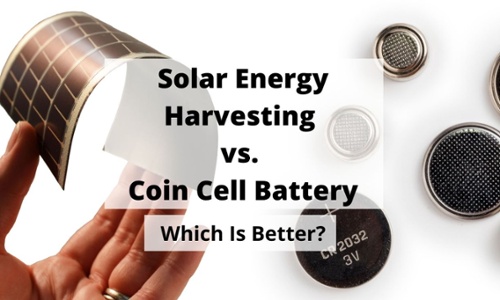
For small, portable electronics, the 3V coin cell battery is the go-to power solution.
Why?
They are inexpensive and simple to use.
Many microcontrollers, sensors, and reference designs are built around coin cell batteries, making designing with them very easy. Since they are so popular, mass production has also made them very affordable.
So, if coin cells are such a great solution, what’s the point of energy harvesting?
Energy harvesting extends battery life, expands functionality and resilience, and enables compact and flexible devices. Let’s dig in.
Take this blog post with you!
Extend Battery Life
Battery life is often measured in months, rather than years.
Dead batteries must be recharged or replaced, putting a heavy maintenance burden and cost on end-users and hindering wider spread implementation of more extensive IoT networks.
Smart homes of the future could have upwards of a hundred nodes, while large buildings and industrial complexes could have thousands.
Extending battery life to be greater than 5-10 years is critical to making these systems practical and economical.
Battery life is a problem for large networks, but it can also make wearables and other portable electronics impractical. By some estimates, half of consumers stop using wearables within a few months of purchase. Taking the device off to recharge the battery is a significant reason for that.
In many low power applications, solar energy harvesting can fully supplement a device's power needs, removing the concept of battery life altogether and enabling perpetual, maintenance-free systems.
Expand Functionality and Resilience
Batteries have a finite amount of energy. To achieve an acceptable battery life, IoT solution providers often cut features or reduce functionality to ensure that limited power lasts the entire life of the device.
A constant power source, like solar harvesting, means more power available and no risk of running out. This can translate into more data, more sensors, more transmissions, longer range, more updates, or other critical features.
Increasing in popularity, over-the-air firmware updates allow large IoT networks to be managed and maintained with ease, but at a significant energy cost. In some cases, a full firmware update can consume up to 2% of the total battery capacity, which severely limits the total number of allowed updates over a device's lifetime.
Devices are also unable to recover from unexpected high power events, such as unscheduled firmware updates, loss of connection, or over-use.
For cellular devices, using protocols such as NB-IoT and LTE-M, maintaining cell tower connection is critical for low power operation. A loss of connection requires searching and re-negotiation (a very power-intensive process that may or may not succeed).
Solar energy harvesting ensures that a device can recover, no matter what unpredictable event occurs.
Enable Compact, Flexible Devices
Batteries take up significant physical space compared to the electronics they power. Enclosure and device dimensions are often designed based on the size and physical limitations of batteries.
This is problematic for wearables, and other low profile electronics where reducing bulk and volume is critical. The batteries in these devices can take up over 25% of total device volume.
In many cases, a battery is also the limiting factor for overall device thickness. The most popular coin cell battery available, a CR2032, has a thickness of 3.2mm. This may sound thin, but many devices become bulky after factoring in an enclosure, PCB, and any other components.
Battery solutions for flexible electronics are also severely lacking and, for many use cases, non-existent.
PowerFilm’s energy-harvesting solar material has a base thickness of only 0.2mm and is highly flexible, with a bend radius of less than an inch.
Solar energy harvesting enables compact wearables, low profile telematics devices, and other flexible applications where traditional battery solutions can’t meet the physical requirements.
The coin cell battery has enabled many applications in IoT, but recognizing its weaknesses enables the next generation of low power perpetual electronics.
Low power devices that require long lifetime, expanded functionality, increased resilience, or a thin/flexible profile, can benefit from a solar energy harvesting solution.
If you have questions or an application in mind, contact us to see how we can meet your power needs.
Take this blog post with you!